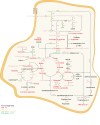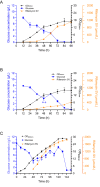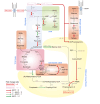Continuous carbon source supply is essential for high rifamycin productivity of Amycolatopsis mediterranei in nitrate-stimulated fermentation revealed by a metabolomic study
- PMID: 39849912
- PMCID: PMC12130708
- DOI: 10.3724/abbs.2024245
Continuous carbon source supply is essential for high rifamycin productivity of Amycolatopsis mediterranei in nitrate-stimulated fermentation revealed by a metabolomic study
Abstract
Amycolatopsis mediterranei U32 is an industrial strain capable of producing therapeutically useful rifamycin SV. In early days of fermentation studies, nitrate was found to increase the yield of rifamycin along with globally, affecting both carbon and nitrogen metabolism in favor of antibiotic biosynthesis; thus, the nitrate-stimulating effect (NSE) hypothesis was proposed. Although GlnR is likely the master regulator of the pleotropic effect of NSE, the global metabolism affected by NSE has never been systematically examined. In this study, we use mass spectrometry-based metabolomics to quantitatively monitor the metabolomic responses of A. mediterranei U32 to nitrate supplementation. The concentrations of many metabolites involved in central carbon metabolism, including glucose 6-phosphate, glucose 1-phosphate, UDP-glucose, and acetyl-coenzyme A, decrease significantly after the addition of 80 mM potassium nitrate to the medium. We find that the rifamycin SV production yield could be increased by the addition of glucose during the logarithmic growth phase. Moreover, at multiple time points during glucose supplementation in the mid- and late-exponential phases, the yield of rifamycin SV further increases, reaching 354.3%. Quantitative real-time PCR assays of the key genes corresponding to the synthesis of the rifamycin SV precursor combined with data from metabolomics analysis confirm that carbon source deficiency is compensated for after glucose supplementation and that the expression of genes involved in the pathway of 3-amino-5-hydroxybenzoic acid synthesis by UDP-glucose and glutamine is significantly increased. This preliminary exploration of dynamic metabolomic profiles has the potential to increase our understanding of the NSE.
Keywords: glucose supplementation; metabolome; nitrate-stimulating effect; rifamycin SV production.
Conflict of interest statement
The authors declare that they have no conflict of interest.
Figures





Similar articles
-
A preliminary study of the mechanism of nitrate-stimulated remarkable increase of rifamycin production in Amycolatopsis mediterranei U32 by RNA-seq.Microb Cell Fact. 2015 Jun 4;14:75. doi: 10.1186/s12934-015-0264-y. Microb Cell Fact. 2015. PMID: 26041361 Free PMC article.
-
MoeA, an enzyme in the molybdopterin synthesis pathway, is required for rifamycin SV production in Amycolatopsis mediterranei U32.Appl Microbiol Biotechnol. 2002 Oct;60(1-2):139-46. doi: 10.1007/s00253-002-1093-6. Epub 2002 Aug 22. Appl Microbiol Biotechnol. 2002. PMID: 12382055
-
GlnR positive transcriptional regulation of the phosphate-specific transport system pstSCAB in Amycolatopsis mediterranei U32.Acta Biochim Biophys Sin (Shanghai). 2018 Aug 1;50(8):757-765. doi: 10.1093/abbs/gmy073. Acta Biochim Biophys Sin (Shanghai). 2018. PMID: 30007316
-
["Nitrate stimulating effect" in Amycolatopsis mediterranei--from discovery to mechanistic studies].Sheng Wu Gong Cheng Xue Bao. 2015 Jun;31(6):845-56. Sheng Wu Gong Cheng Xue Bao. 2015. PMID: 26672361 Review. Chinese.
-
Amycolatopsis mediterranei: A Sixty-Year Journey from Strain Isolation to Unlocking Its Potential of Rifamycin Analogue Production by Combinatorial Biosynthesis.J Nat Prod. 2024 Feb 23;87(2):424-438. doi: 10.1021/acs.jnatprod.3c00686. Epub 2024 Jan 30. J Nat Prod. 2024. PMID: 38289177 Review.
References
-
- Murali Krishna PS, Venkateswarlu G, Venkateswar Rao L. Effect of uracil on rifamycin SV production by Amycolatopsis mediterranei MV35R . Lett Appl Microbiol. . 2000;31:73–76. doi: 10.1046/j.1472-765x.2000.00769.x. - DOI - PubMed
-
- Riva S, Silvestri LG. Rifamycins: a general view. Annu Rev Microbiol. . 1972;26:199–224. doi: 10.1146/annurev.mi.26.100172.001215. - DOI - PubMed
MeSH terms
Substances
LinkOut - more resources
Full Text Sources

